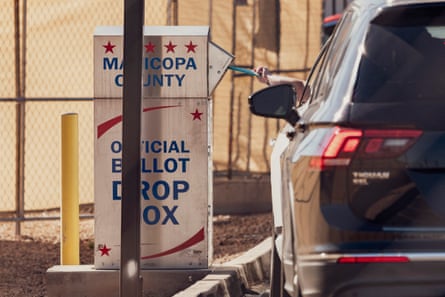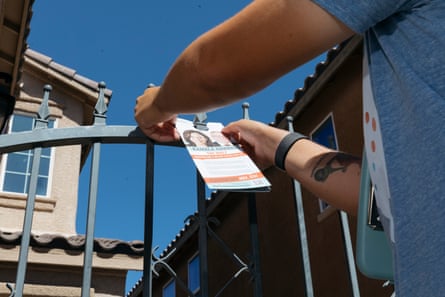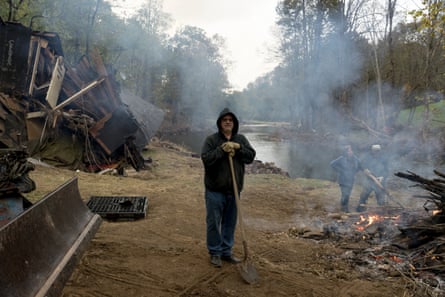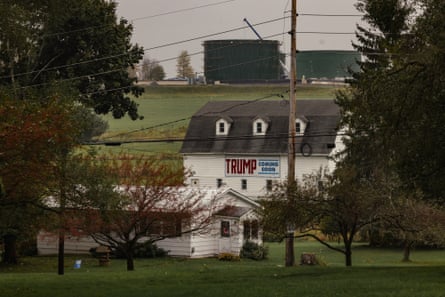Spare a thought for beleaguered Pennsylvanians. During the past few weeks, they have been pummeled with $280m worth of election ads blazing on their TV and computer screens, part of an eye-popping $2.1bn spent so far on the US presidential election.
Pennsylvania is one of the seven battleground states that, when it comes to choosing presidents, can seem as revered as the seven wonders of the world. Forget Democratic California, ditch reliably Republican Texas – it is these seven states that, come 5 November, will decide the outcome of one of the most consequential elections in modern times.
Their names are seared into the minds of politically aware Americans: Arizona, Georgia, Michigan, Nevada, North Carolina, Pennsylvania and Wisconsin. Under America’s arcane electoral system, the occupant of the Oval Office is elected not through the popular vote but by electoral college votes harvested state by state.
Among them, the seven states control 93 electoral college votes (Pennsylvania has the largest number, 19, which is why its residents are so bombarded). In the final days, Donald Trump and Kamala Harris and their running mates, JD Vance and Tim Walz, will be scrambling all over them in a bid to reach the magic number: 270 electoral college votes to win.
The states are called battlegrounds for a reason – their loyalty cannot be taken for granted by either side. This year, though, their unpredictability has reached dizzying heights. The Guardian’s presidential poll tracker shows five of them essentially tied within a three-point margin of error, with only Arizona (where Trump is up four points) and Wisconsin (where Harris is up five) pulling away. Nate Cohn, the New York Times’ polling expert, has drily noted that the presidential polls are “starting to run out of room to get any closer”.
Guardian reporters are on the ground in each of the seven battlegrounds to test these confounding waters.
– Ed Pilkington
Arizona
‘Why isn’t Trump doing a little better here?’

On a stiflingly hot afternoon last month, Lynn and Roger Seeley relaxed into an air-conditioned co-working space in a suburb east of Phoenix. They had come to hear the Democratic candidate for US Senate, Ruben Gallego, make his pitch to a roomful of small-business owners. Lifelong Republicans, they might have felt out of place at a Democratic campaign event in the pre-Trump era. But not now.
“The Arizona Republican party is not the same Republican party,” said Lynn Seeley, who plans to vote for Kamala Harris in November. “It just doesn’t represent me anymore.”
The Seeleys are among a group of disaffected Arizonans known as “McCain Republicans” – moderates and independents who prefer the “maverick” brand of politics of the late Arizona Senator John McCain to Trump’s Maga movement.
The Trumpification of the state GOP, as well as rapid population growth, a large number of young Latino voters and a suburban shift away from the Republican party have created an opening for Democrats in recent election cycles, turning once ruby-red Arizona into a desert battleground.

Polling shows Donald Trump with a narrow edge over Harris in the presidential race. The Senate race, which is critical to the party’s slim hope of maintaining control of the chamber, appears to trend in Gallego’s favor. The state also features two of the most competitive House races in the country, both key to winning the speaker’s gavel. Arizonans are also voting on an initiative to enshrine abortion rights into the state constitution.
Across the sprawling Phoenix region, one of the fastest-growing in America, Trump and Harris signs dot xeriscaped yards. But roughly a third of Arizonans are unaffiliated, and since Trump’s election in 2016 they have broken for Democrats in key statewide races.
In 2020, Trump lost the state by fewer than 11,000 votes, the narrowest of any margin. It was the first time a Democratic presidential candidate had won Arizona since Bill Clinton in 1996, and before then, it was Harry Truman in 1948.
“Arizona is not a blue state,” said Samara Klar, a professor of political science at the University of Arizona. “Arizona has had very high inflation rates, very high increases in the cost of living, and an increase in the cost of gas. It’s a border state during a border crisis. A Republican candidate should be cleaning up in Arizona. So the question is: why isn’t Trump doing a little better here?”
Lauren Gambino | Chandler, Arizona
Georgia
Early voting hits records – but offers few clues

Mary Holewinski lives in Carrollton, Georgia, which is home turf for the far-right representative Marjorie Taylor Greene. But Holewinski is a Kamala Harris supporter and has a sign in her yard. It draws nasty looks, she said: “I’ve lost neighbor friends.”
Those tensions are ratcheting up, because the presidential election is already well under way in Georgia. More than 2 million Georgians – a quarter of its electorate – have already gone to the polls, setting early voting records each day.
Both Harris and Trump consider Georgia – no longer a stereotypical “deep south” state but one propelled by the economic and cultural clout of Atlanta – a crucial pickup. In 2020, the state went for Joe Biden by 11,780 votes
– and Trump has since been charged in an election interference case after calling Georgia’s secretary of state and asking him to “find” those 11,780 votes. A Georgia victory would represent belated validation for the former president.
The candidates may as well have leased apartments in Atlanta, for all the time they’re spending here. The difference between a Democrat winning 80% and 90% of their votes could be larger than the overall margin of victory.
But Georgia is no longer a state defined by Black and white voters. Asian and Latino population growth has changed the political landscape in suburban Atlanta, which helped drive the Biden victory here in 2020. And the conflict between conventional conservative Republicans and the Maga insurgency may also be determinative: suburban moderates in the Atlanta region turned against Trump in 2020, and he has done little since to win them back.
Still, while historically Democrats in Georgia have been more likely to vote early than Republicans, Trump has pointedly instructed his supporters to vote early in person in Georgia, and many appear to be doing just that.
“I could care less about whether you like him or not. It’s not a popularity contest,” said Justin Thompson, a retired air force engineer from Macon. “It’s what you got done. And he did get things done before the pandemic hit. And the only reason why he didn’t get re-elected was because the pandemic hit.”
George Chidi | Atlanta, Georgia
Michigan
Turnout is key in state where many are angry over Gaza

The trade union official had much to say, but he wasn’t going to say it in public.
The leader of a union branch at a Michigan factory, he was embarrassed to admit that most of its members support Donald Trump – even though he’s also disparaging about what he saw as the Democratic party elite’s failure to put the interests of working people ahead of powerful corporations.
“I don’t want to disagree with the members in public because they have their reasons to do what they think is good for protecting their jobs,” he said. “I’ve tried to explain that they’re wrong but they don’t want to hear it.”
Like many in Michigan, he found himself torn: despairing of Trump yet not greatly enthused by Harris. A Rust belt state that once prospered from making cars, steel and other industrial products, Michigan lost many jobs to Mexico after the signing of the North American Free Trade Agreement (Nafta) by Bill Clinton, an enduring source of resentment against the Democrats for some voters that helped Trump to power.
That goes some way to explain why opinion polls continue to have the two candidates neck-and-neck in Michigan, even though the Harris campaign is heavily outspending Trump here and appears to have a better ground game with more volunteers.
Turnout will be key: Trump won here by just 10,704 votes in 2016, then lost narrowly to Biden four years later. High on the list of demographic targets are Black voters in Michigan’s largest city, Detroit, whose low turnout in 2016 was a factor in Hillary Clinton’s defeat in the state. Harris is also targeting white suburban women, many of whom previously supported Trump but have cooled on him over abortion rights, his continued false claims of election fraud and his criminal convictions.
For all of that, the election in Michigan may be decided by events far away.
More than 100,000 Michigan Democrats, many of them from the state’s Arab American community around Detroit, abstained from supporting Biden in the Democratic primaries earlier this year because of his support for Israel’s war in Gaza. So far, Harris has not significantly wavered from Biden on the issue. With polls this close, it could be decisive if Harris loses a fraction of these voters.
Chris McGreal | Saginaw, Michigan
Nevada
Is Harris or Trump better for the working class?

Urbin Gonzalez could have been working inside, in the air conditioning, at his regular job as a porter on the Las Vegas Strip. Instead, in the final days before the US election, he had chosen to go door-knocking in the 104F (40C) heat.
“I don’t care because I’m fighting for my situation,” said Gonzalez, dabbing the sweat from his neck. “All Trump wants to do is cut taxes for his buddies, for his rich friends, not for us. Not for workers … This is personal.”
While the US economy broadly bounced back from the pandemic, Nevada has lagged behind. Nearly a quarter of jobs here are in leisure or hospitality, and although the Las Vegas Strip, where Gonzalez works, is back to booming with tourists, unemployment in Nevada remains the highest of any US state, and housing costs have skyrocketed.
Both Trump and Harris have promised to turn things around: both have promised to eliminate federal income taxes on workers’ tips, and both have vowed to expand tax credits for parents – though their plans widely differ when it comes to the finer points.
Although Nevada has leaned Democratic in every presidential election since 2008, winning candidates have scraped by with slim margins. About 40% of voters don’t identify with either Democrats or Republicans, and although a growing number of Latino voters – who now make up 20% of the electorate – have traditionally backed Democrats, the party’s popularity is slipping.
The state, which has just six electoral votes, is notoriously difficult to accurately poll – in large part because the big cities, Reno and Las Vegas, are home to a transient population, many of whom work unpredictable shifts in the state’s 24/7 entertainment and hospitality industries. But many voters remember the days early in the Trump administration when costs were lower. “I think the economy was just better when Trump was president,” said Magaly Rodas, 32, while shopping at her local Latin market. Her husband, an electrician, has struggled to find work since the pandemic, while rent and other expenses have continued to climb. “What have the Democrats done for us in four years?”
Maanvi Singh | Las Vegas, Nevada
North Carolina
A hurricane is a wild card that could depress turnout

Kim Blevins, 55, knows what it’s like to survive a disaster. She was locked inside her home without power for eight days when Hurricane Helene struck western North Carolina last month.
So when she uses the experience as a frame through which to view the impending election, she is not being frivolous. “If Trump doesn’t get in, it’s going to be worse than the hurricane,” she said.
“It’ll be world war three. Kamala Harris wants to make us a communist country and we can’t survive that. The illegals coming over the border, the inflation of food and gas prices, we can’t do that.”
Hurricane Helene has raised a critical challenge for Donald Trump.
It affected a rural mountainous region that is Trump’s natural base – some 23 out of the 25 stricken counties are majority-Maga. So any decline in turnout would most likely hurt him.
Trump needs to win North Carolina if he is to have an easy shot at returning to the White House. The state veers Republican, only voting for a Democratic president twice in recent times (Jimmy Carter in 1976 and Barack Obama in 2008). Trump took it in 2020 by just 75,000 votes.
Yet Harris has succeeded since she took over the Democratic mantle from Joe Biden in making this race neck-and-neck.
In the final stretch, Trump is focusing on getting his base of largely white rural voters to the polls, hurricane be damned. His campaign has been heartened by the first week of early voting, which has smashed all records, with Republicans almost matching Democrats in turnout. (In 2020 and 2016, Republicans lagged behind.)
On her side, Harris is waging an intense ground game, with hundreds of staffers fanning out across the state to squeeze out every vote. The thinking is that if Trump can be blocked in North Carolina, he can be stopped from regaining power.
For that to happen, Harris has to mobilize her broad tent of support, with special emphasis on women in the suburbs of Charlotte and Raleigh-Durham. She is also trying to shore up the male African American vote, which has shown some softness.
Not least, she is trying to tie Trump to Mark Robinson, the state’s Republican gubernatorial candidate. Robinson has described himself as a “Black Nazi”, and has been revealed to have made extreme racist remarks.
Ed Pilkington | Creston, North Carolina
Pennsylvania
‘If we win Pennsylvania, we win the whole thing’

Pennsylvania provided one of the most enduring images of the fraught US election cycle: Donald Trump raising his fist to a crowd of supporters after a gunman attempted to end his life at a campaign rally in July. As Trump left the stage in Butler, Pennsylvania, with blood dripping from his ear, his supporters chanted: “Fight! Fight!”
Days later, Joe Biden withdrew from the presidential race, clearing the way for Kamala Harris to ascend to the Democratic nomination.
Both Trump and Harris have returned to Pennsylvania dozens of times since, confirming that the Keystone state could play a definitive role in the presidential race. “If we win Pennsylvania, we win the whole thing,” Trump said at a rally in Pennsylvania last month. “It’s very simple.”
As the fifth-most-populous US state, Pennsylvania has the most electoral votes of any of the battlegrounds. Much of the population is clustered around Philadelphia and smaller cities like Pittsburgh and Scranton, where Biden showed strength in 2020, but the more rural regions could play an outsized role in the election. White, blue-collar voters in these rural areas have sharply shifted away from Democrats in recent elections.
Some Democrats expected Harris to choose the popular governor of Pennsylvania, Josh Shapiro, as her running mate, given his impressive ability to secure consistent victories in such a closely-contested state. Harris instead chose Tim Walz, the Minnesota governor, a decision that could come back to haunt her depending on the results in Pennsylvania.
In her bid to sway undecided voters, Harris has walked back some of her most progressive proposals from her 2020 presidential campaign – such as a ban on fracking, a major industry in Pennsylvania, on which she has now reversed her stance.
It could all come down to Pennsylvania. Tom Morrissey, a 67-year-old voter from Harleysville attending a Democratic campaign event last month, was optimistic . “We love the enthusiasm. It’s so important at this time,” Morrissey said. “We have to save democracy.”
Joan E Greve | Ambler, Pennsylvania
Wisconsin
‘Let the anxiety wash over you and then refocus’

Wearing matching hats emblazoned with the words “Sauk County Democrats”, Deb and Rod Merritt, a retired couple from southern Wisconsin, joined the crowd to hear Barack Obama stump for Kamala Harris.
“We’re so apprehensive that the polls say they’re close,” said Rod Merritt.
Sauk county is one of a handful of Wisconsin counties that has flipped from Democrats to Republicans and back. It’s exactly the kind of place – a swing county in a swing state – that the campaigns are fighting over.
A midwestern state in the Great Lakes region known for dairy production, manufacturing and healthcare, Wisconsin is considered to be part of the “blue wall” – the states Democrats consistently won in the 1990s and early 2000s.
Trade unions historically helped drive voter turnout for Democrats, but a series of anti-labor laws passed under the Republican-controlled state government in 2011 dealt them a blow. Rural areas have increasingly turned to Republican candidates, leaving cities like Milwaukee – Wisconsin’s most racially diverse – and the liberal stronghold of Madison as Democratic bastions.
With the economy the top issue, it all comes down to turnout, with Republicans focusing on rural voters and young men, who have increasingly looked to conservative politics.
The Democrats, meanwhile, hope the closeness of the race – in which a half-million people have already voted – will mobilize volunteers. “In some ways, the most important thing is learning some breathing exercises so that you can let the anxiety wash through you – and then refocus on knocking on the next door,” said Ben Wikler, the chair of the Democratic party of Wisconsin.
Alice Herman | Madison, Wisconsin




